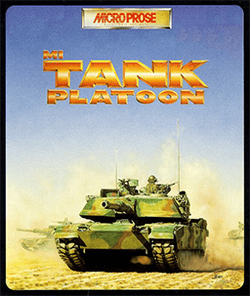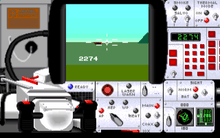M1 Tank Platoon
| M1 Tank Platoon | |
|---|---|
 Cover art | |
| Developer(s) | MicroProse |
| Publisher(s) | MicroProse |
| Designer(s) | Arnold Hendrick, Scott Spanburg |
| Platform(s) | Amiga, Atari ST, DOS |
| Release date(s) | 1989 |
| Genre(s) | Simulation Real-time tactics |
| Mode(s) | Single player |
M1 Tank Platoon is a tactical simulation of tank warfare, released by MicroProse for the Commodore Amiga, Atari ST and DOS in 1989. It featured a mixture of first-person tank warfare and tactical simulation gameplay. It was followed by a sequel, M1 Tank Platoon II, which was released by MicroProse in 1998 for Windows. M1 Tank Platoon was sold to Interplay Entertainment on March 27, 2009.[1]
Gameplay

The player is put in the position of a main battle tank platoon commander in charge of four U.S. M1 Abrams tanks in a fictional campaign of battles against the Soviet Army in Central Europe. The player can give orders to friendly units via a tactical map of the battle area as well as taking control of a single tank - assuming the role of either the tank commander, driver or gunner.
Depending on the player's tastes, the whole game could be played more like an action/simulation game or like a strategy game. As platoon commander, direct control is limited to the four M1 tanks, however depending on the mission, support units like recon and attack helicopters, M2 Bradley infantry fighting vehicles, MLRS artillery systems or other older M60 Patton tanks were available and could be given orders via the tactical map.
One feature of the game was the ability to change the viewpoint to a supporting unit to get a "recon" from that unit's perspective. According to the manual, doing this from the M1 tanks was supposedly approximate to a tank commander standing on his tank hull to get a better perspective. This external view feature was also very good (for the time) for cinematic experiences like the "director's chair" where the viewpoint is set to a helicopter doing reconnaissance. The external view was also able to track other objects in the centre of the view. This was not limited to vehicles but could actually track missiles or even tank rounds.
Between the battles, surviving crew members increase in military rank and skill—giving the player an incentive to keep his team alive.
The Campaign typically depicted the rush across the Rhine by the numerically superior enemy forces. The Campaign would therefore start as defensive with the challenge being to use technologically superior NATO vehicles to stem the "wave" of Warsaw Pact vehicles. Success would mean the scenarios gradually put NATO on the offensive side with objective waypoints to reach/hold.
Terrain was a very important factor as going hull down was a critical strategy to surviving. Full use of the supporting forces made success easier with even the infantry disembarking from their IFVs to use M47 Dragon anti-tank launchers. However, leaving them in one position too long invited an artillery barrage from the opposing force.
Reception
An United States Army Reserves officer and graduate of Armor School stated in Computer Gaming World that M1 Tank Platoon was the first computer tank game to give the player control over four tanks instead of one. He favorably reviewed the game's documentation, internal and external graphics, and depiction of interdependent combat arms, and concluded that it was "the best armor simulator currently available".[2] A 1992 survey by the same author of wargames with modern settings gave the game four stars out of five.[3] The game got 5 out of 5 stars in Dragon.[4]
It sold 500,000 copies, a large amount by the standards of the time.
In 1990 Computer Gaming World named it as Simulation Game of the Year,[5] and in 1996, the magazine ranked it as the 32nd best PC game of all time.[6]
Sequel
See also
- Super Battletank, a simulator released in 1992 by Absolute Entertainment
- Team Yankee, a tactical simulator released in 1990 by Empire Interactive
References
- ↑ http://www.interplay.com/about/article.php?id=25
- ↑ Brooks, M. Evan (December 1989). "M1 Tank Platoon". Computer Gaming World. p. 24.
- ↑ Brooks, M. Evan (June 1992). "The Modern Games: 1950 - 2000". Computer Gaming World. p. 120. Retrieved 24 November 2013.
- ↑ Lesser, Hartley; Lesser, Patricia; Lesser, Kirk (February 1990). "The Role of Computers". Dragon (154): 76–83.
- ↑ "CGW's Game of the Year Awards". Computer Gaming World. September 1990. p. 70. Retrieved 16 November 2013.
- ↑ CGW 148: 150 Best Games of All Time